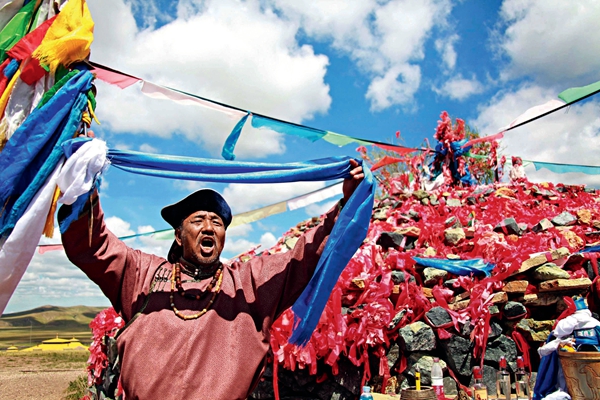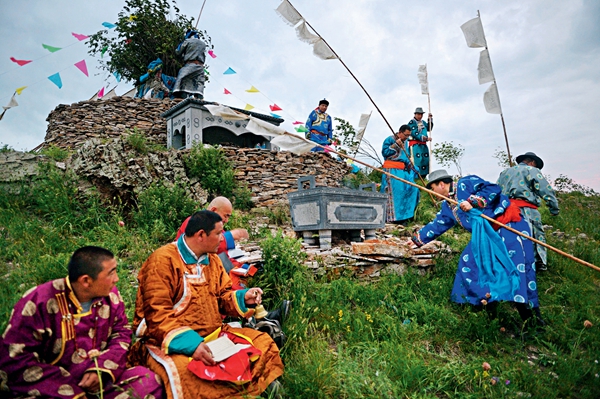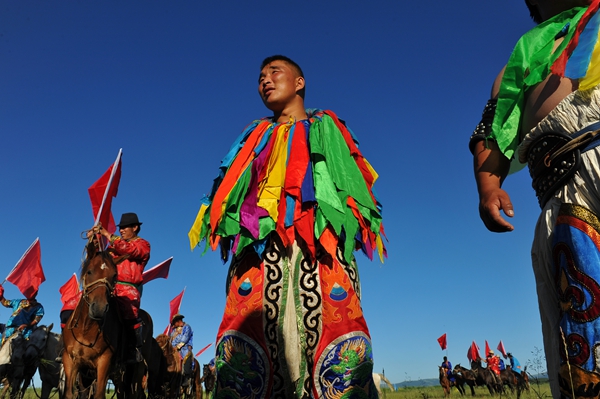Aobao Worship
THE full moon ascends the heavens. Why are there no clouds? I await you, beautiful maiden. Why do you not come to my side?” So goes the theme song from a film made in the 1950s about people of the Mongolian ethnic group living on the Inner Mongolian prairie. It is inspired by the ceremonial ritual that Mongolians perform on the grassland on specific dates.
Aobao, or Obo, means “heap” in Mongolian. It describes a huge, often pyramid-shaped mound of earth or stones – a cairn – on whose summit is planted a group of tall, ceremonially adorned willow branches. It is traditional among Mongolian travelers to dismount at aobaos to pray for a safe journey, and to add a handful of earth or stones to them before setting off. A grand aobao worship event takes place annually. The ritual was acknowledged as a national intangible cultural heritage in 2006.
Religious and Historical Origins
Mongolians are believers in Shamanism, and offer prayers to Munkh Khukh Tengri, or the Eternal Blue Sky. Mongolian ancients believed that the sky and earth are as one. The sky they regarded as their loving father and sustainer of life, and the fertile earth as their beneficent mother and giver of the physical body. This conviction endows on Mongolians a deep reverence for mountains and rivers, each of which they believe has its own deity. In the absence of anthropomorphic icons of these elements of nature, the Mongolians created aobaos.

These cairns are normally built on dunes or hill tops, and vary in height. Several theories exist about their origins. One is that they served as boundary markers on the vast grasslands in early times. With the passing of millennia, the structures became revered as the abodes of holy spirits to whom sacrifices were made.
Another explanation is that aobaos were monuments to fallen warriors. Early Mongolian history was fraught with tribal wars in contention for high ground as vantage points. The victors would bury their dead on the hill top and cover the tombs with rocks. Relentless battles might result in a single hill being the burial ground for warriors of several rival tribes. After taking control of the area, the winning tribe would duly mourn and offer sacrifices, and the tombs would grow tall from the rocks added to them. Aobaos thus came into being.
Aobao worship is, however, polytheist, and not confined to the worship of heaven and earth. It is a key element of the nomadic Mongolian culture.
Demarcated Aobao
Each aobao has a specific ceremonial function. There are some that pay homage to Genghis Khan or other historical heroes. Others are associated with particular tribes, families or clans. Still others are Shamanistic. There is a story behind every aobao.

Ancient aobaos in Inner Mongolia were mostly built with rocks and tree branches in the shape of a pagoda. More recent ones have a wider scope of shapes and forms, often built of bricks, cement or colorful ceramics. But whether old or recent, aobaos are always prominently located – on hilltops, above passes, on lake shores, and at roadsides, and often tapering three-tier stone structures on a circular base.
Aobaos in eastern Inner Mongolia consist of a pole planted at the center of an arched summit and encircled with decorative tree branches. Three more poles are erected on the east, west, and north of the aobao. They are carved respectively with images of the sun, moon, and clouds, and fastened with colored ribbons that converge towards the central pole. These ribbons are festooned with khata (ceremonial scarves) and prayer banners, called Wind Horses. Aobaos in Ordos, southwestern Inner Mongolia, often face a Wind Horse altar, with a shrine and a table on the sunny side where candles and incense are placed and lit.
Aobaos may stand alone or in clusters. In the latter instance a large aobao is flanked by three to 25 smaller ones. They stand either in a row or in the shape of a cross. It was the spread of Tibetan Buddhism in Mongolian-inhabited areas that introduced the Buddhist elements of the ceremonial scarf, prayer banners, Buddhist shrines and incense, to the aobao design and worship rituals.
Sacrificial Offering
Different origins and purposes of aobaos, along with natural conditions of specific regions, have given rise to variances in aobao worship ceremonies as regards the dates on which they take place, as well as extent and form. They are usually held annually – from the fifth to the seventh month of the lunar calendar, and sometimes twice a year if the weather is exceptionally good. The ceremony generally takes place from dawn to dusk, but may carry on for three, five or seven days at aobaos of particular significance.

The rite is classified according to the sacrifice made – blood, a libation, fire, or jade. Makers of blood sacrifices kill the fattest bull or sheep in their herd and place them in front of the aobao. This is rare nowadays. For libations, milk, cream and fermented milk is sprinkled in front of the aobao. For fire sacrifices, a pile of branches or dried dung is lit, and those attending walk around the fire three times, chanting their family names while throwing mutton on the flames. Shamanism regards fire as supreme purity, whereby the higher the flame, the more successful the sacrificial rite. As jade was highly valued in ancient China, it played a central role in pagan and ancestor worship. It was believed to be possessed of the magic power to bridge the temporal and eternal worlds. Mongolian people hence offered jade items to their aobaos.
On the day of the ceremony, Mongolians gather at the aobao, dressed in their best. They circumambulate clockwise, three times, adding rocks to the heap in the process, and kowtow before the shrine. They then decorate the aobao with the scarves, banners, and ribbons they have brought from home and lay out the sacrificial objects. These might include a sheep, libations of, tea, liquor, fermented milk or congee, a ceremonial scarf, butter, cheese, and pastry.
A divine animal is often selected and baptized at the worshipful ceremony. After being bathed in milk and adorned with colored ribbons its owner leads it around the aobao while carrying a torch. As it is divine, the animal cannot be slaughtered, or whipped or ridden, for the rest of its life. After dying a natural death its remains are placed at the aobao.
At the end of the ceremony, certain sacrificial items are presented to elders whom the entire clan venerates. The rest are shared by all participants. Mongolians believe that such sacrifices are auspicious for them and their families.
On leaving the aobao, participants usually sit in groups to feast and enjoy entertainment. Cultural activities – such as wresting, archery and sheep-snatching from horseback – have been incorporated into aobao worship over the centuries of its evolution, transforming the day into a minor Nadaam (a mid-summer celebration) festival.
(Compiled by China Today)
Services
Economy
- BRICS Welcomes Its Second Decade
- Forging a “Two-Wheel Drive” for Sino-U.S. Economic and Trade Relations
- Tong Ren Tang: Envoy of Traditional Chinese Medicine
- Chinese Manufacturing Sector Rides Fourth Industrial Revolution Wave
- China, Sri Lanka Strengthen Cooperation on Maritime Silk Road Interview with Sri Lankan Ambassador to China Karunasena Kodituwakku
